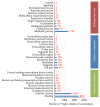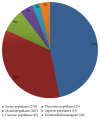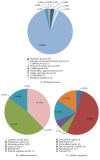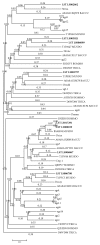Next Generation Sequencing Identifies Five Major Classes of Potentially Therapeutic Enzymes Secreted by Lucilia sericata Medical Maggots
- PMID: 27119084
- PMCID: PMC4826915
- DOI: 10.1155/2016/8285428
Next Generation Sequencing Identifies Five Major Classes of Potentially Therapeutic Enzymes Secreted by Lucilia sericata Medical Maggots
Abstract
Lucilia sericata larvae are used as an alternative treatment for recalcitrant and chronic wounds. Their excretions/secretions contain molecules that facilitate tissue debridement, disinfect, or accelerate wound healing and have therefore been recognized as a potential source of novel therapeutic compounds. Among the substances present in excretions/secretions various peptidase activities promoting the wound healing processes have been detected but the peptidases responsible for these activities remain mostly unidentified. To explore these enzymes we applied next generation sequencing to analyze the transcriptomes of different maggot tissues (salivary glands, gut, and crop) associated with the production of excretions/secretions and/or with digestion as well as the rest of the larval body. As a result we obtained more than 123.8 million paired-end reads, which were assembled de novo using Trinity and Oases assemblers, yielding 41,421 contigs with an N50 contig length of 2.22 kb and a total length of 67.79 Mb. BLASTp analysis against the MEROPS database identified 1729 contigs in 577 clusters encoding five peptidase classes (serine, cysteine, aspartic, threonine, and metallopeptidases), which were assigned to 26 clans, 48 families, and 185 peptidase species. The individual enzymes were differentially expressed among maggot tissues and included peptidase activities related to the therapeutic effects of maggot excretions/secretions.
Figures






Similar articles
-
Towards next generation maggot debridement therapy: transgenic Lucilia sericata larvae that produce and secrete a human growth factor.BMC Biotechnol. 2016 Mar 22;16:30. doi: 10.1186/s12896-016-0263-z. BMC Biotechnol. 2016. PMID: 27006073 Free PMC article.
-
Characterisation of the small RNAs in the biomedically important green-bottle blowfly Lucilia sericata.PLoS One. 2015 Mar 24;10(3):e0122203. doi: 10.1371/journal.pone.0122203. eCollection 2015. PLoS One. 2015. PMID: 25803701 Free PMC article.
-
Urate Oxidase produced by Lucilia sericata medical maggots is localized in Malpighian tubes and facilitates allantoin production.Insect Biochem Mol Biol. 2017 Apr;83:44-53. doi: 10.1016/j.ibmb.2017.02.007. Epub 2017 Feb 22. Insect Biochem Mol Biol. 2017. PMID: 28235562
-
Does maggot therapy promote wound healing? The clinical and cellular evidence.J Eur Acad Dermatol Venereol. 2016 May;30(5):776-82. doi: 10.1111/jdv.13534. Epub 2015 Dec 21. J Eur Acad Dermatol Venereol. 2016. PMID: 26691053 Review.
-
Multiple actions of Lucilia sericata larvae in hard-to-heal wounds: larval secretions contain molecules that accelerate wound healing, reduce chronic inflammation and inhibit bacterial infection.Bioessays. 2013 Dec;35(12):1083-92. doi: 10.1002/bies.201300071. Epub 2013 Oct 7. Bioessays. 2013. PMID: 24123092 Review.
Cited by
-
Expression of a New Recombinant Collagenase Protein of Lucilia Sericata in SF9 Insect Cell as a Potential Method for Wound Healing.Iran J Biotechnol. 2019 Dec 1;17(4):e2429. doi: 10.30498/IJB.2019.92707. eCollection 2019 Dec. Iran J Biotechnol. 2019. PMID: 32671126 Free PMC article.
-
European Medicinal Leeches-New Roles in Modern Medicine.Biomedicines. 2020 Apr 27;8(5):99. doi: 10.3390/biomedicines8050099. Biomedicines. 2020. PMID: 32349294 Free PMC article. Review.
-
Profiling antimicrobial peptides from the medical maggot Lucilia sericata as potential antibiotics for MDR Gram-negative bacteria.J Antimicrob Chemother. 2019 Jan 1;74(1):96-107. doi: 10.1093/jac/dky386. J Antimicrob Chemother. 2019. PMID: 30272195 Free PMC article.
-
Maggot extract accelerates skin wound healing of diabetic rats via enhancing STAT3 signaling.PLoS One. 2024 Sep 6;19(9):e0309903. doi: 10.1371/journal.pone.0309903. eCollection 2024. PLoS One. 2024. PMID: 39240845 Free PMC article.
-
New Insights Into Culturable and Unculturable Bacteria Across the Life History of Medicinal Maggots Lucilia sericata (Meigen) (Diptera: Calliphoridae).Front Microbiol. 2020 Apr 8;11:505. doi: 10.3389/fmicb.2020.00505. eCollection 2020. Front Microbiol. 2020. PMID: 32322242 Free PMC article.
References
MeSH terms
Substances
LinkOut - more resources
Full Text Sources
Other Literature Sources
Molecular Biology Databases
Research Materials
Miscellaneous

